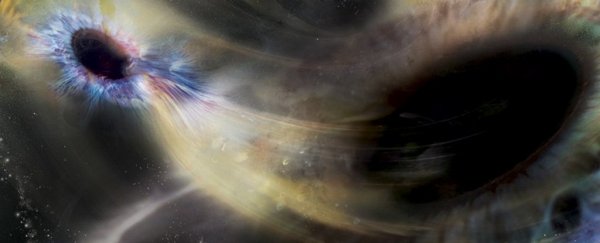It was one of the biggest moments in recent memory when an international team of physicists announced that they'd made the first direct observations of gravitational waves since Einstein first proposed them a century ago.
Now, just four months later, an Australian team has announced the second such achievement - they've directly detected gravitational waves caused by the collision of two black holes that are up to 14 times the size of our Sun.
"This has cemented the age of gravitational wave astronomy," said one of the team, Susan Scott, an astrophysicist from the Australian National University (ANU) in Canberra. "This shows data is going to flow, that will enable us to map a lot more of the Universe than we've seen before."
Scott and her team have been analysing data collected by the two Laser Interferometer Gravitational-Wave Observatory (LIGO) detectors in the US - the same detectors that picked up that historic gravitational wave signal on 14 September 2015, before it was analysed and announced in February.
On 26 December 2015, Australian researchers caught a glimpse of two black holes orbiting each other 27 times in their last second before colliding. The blast signal that resulted was 10 times longer than that of the first gravitational wave, and now the team has finally had a chance to analyse it.
They've figured out that this collision actually happened 1.4 billion years ago, in a galaxy so distant, the resulting shockwaves have only just reached us.
Predicted by Einstein back in 1916, gravitational waves are ripples in the curvature of spacetime that emanate from the most explosive and violent events in the Universe, such as a star exploding or a black hole merger.
These ripples spread out through space like the ripples in a pond after a stone's been tossed in, and - in the two cases we've been able to detect them - by the time those ripples get to us on Earth, they're tiny. We're talking around a billionth of the diameter of an atom.
Einstein himself predicted that humans would never be able to detect them because of how minuscule their signal would be. Until these LIGO observations, scientists have been making sense of the Universe based on electromagnetic observations that our instruments can detect, such as visible light emissions, radio waves, and X-rays.
Being able to reliably detect gravitational waves too means we have an entirely new way to 'see' and measure the objects and events in space around us.
"I'd always imagined there would be electromagnetic counterparts in our first discoveries, but instead we found these invisible collisions of black holes purely through the gravitational waves they emitted, with no counterparts at all," says one of the team, Rob Ward. "Gravitational wave astronomy is going to revolutionise our understanding of the Universe."
The team's analysis has been published in Physical Review Letters.
